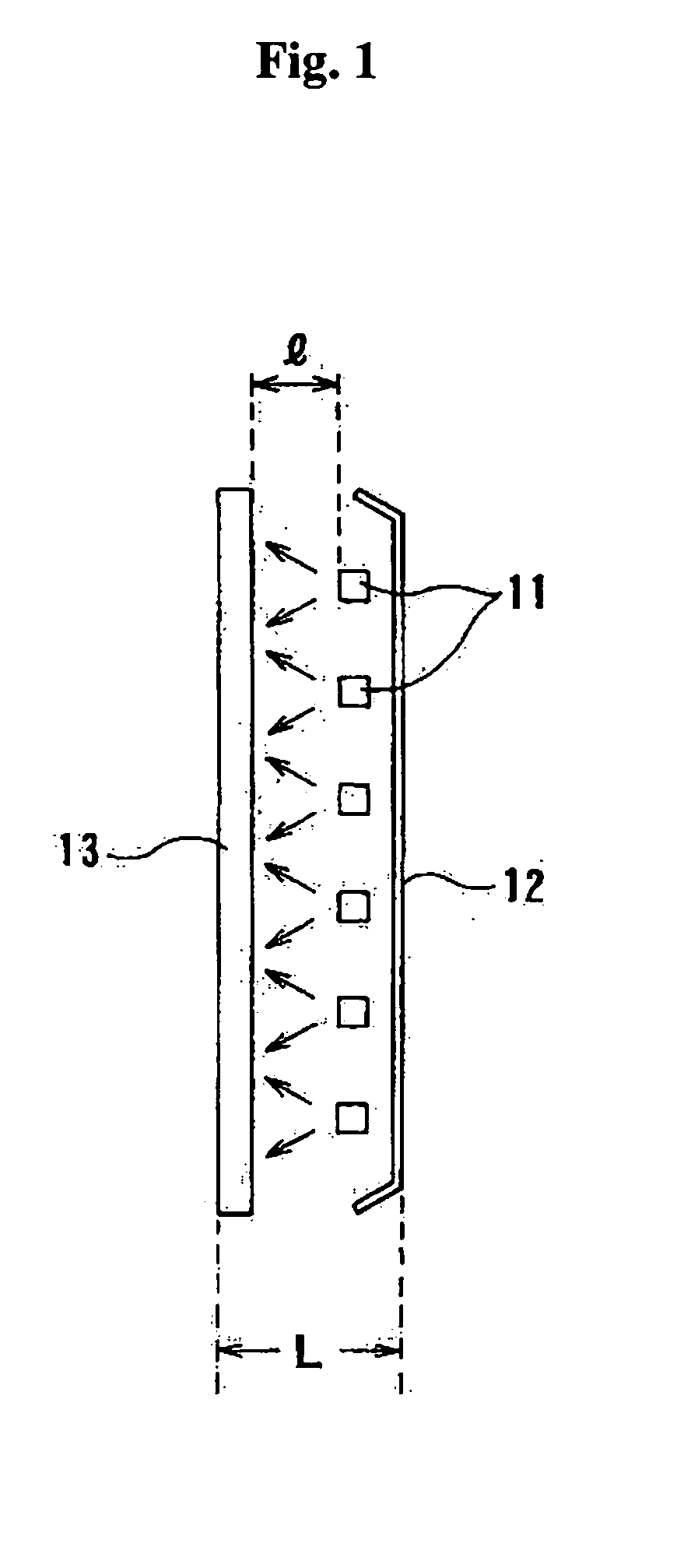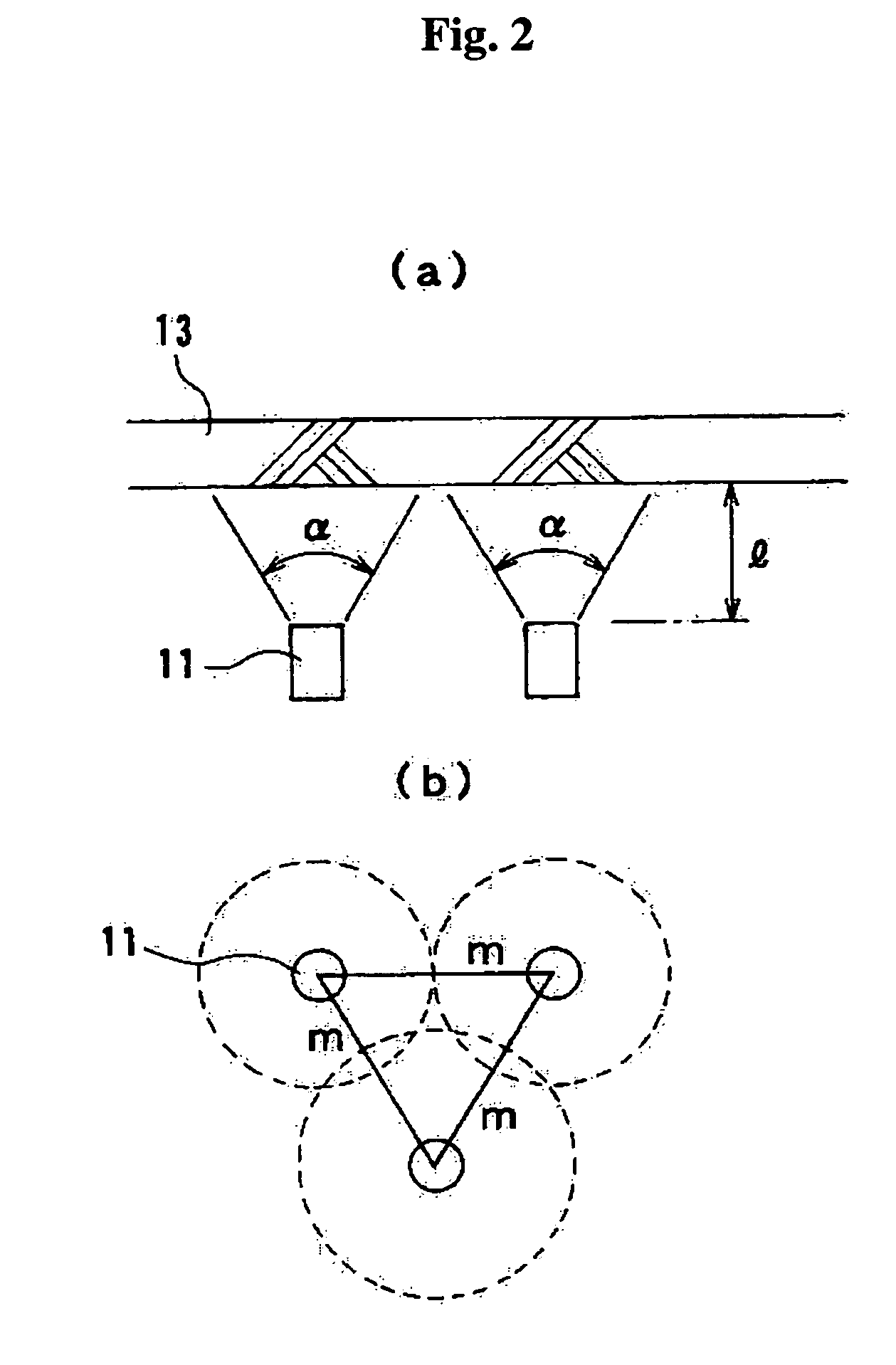Light-Emitting Planar Body-Structured Body
a planar body and light-emitting technology, applied in the field of can solve the problems of large restriction of self-luminous type light-emitting planar body structure using black light, inability to appraise design, etc., and achieve the effect of expanding the area
- Summary
- Abstract
- Description
- Claims
- Application Information
AI Technical Summary
Benefits of technology
Problems solved by technology
Method used
Image
Examples
example 1
[0071] Two types of phosphorescent light-emitting planar body (3.0 mm in thickness), whose composition is shown in Table 1, were prepared, and were set in a zigzag arrangement as shown in FIG. 2 by using a diffusion type ultraviolet-emitting LED (NICHIA CORPORATION, NSHU:550: 5-mm diameter, light output 700 μW, diffusion angle 100°). In the arrangement, m=60 mm and l=30 mm. A reflector plate was used to give a total thickness of L=50 mm. The LED light source was not perceived at all from the front side of the light-emitting planar body.
[0072] Uniform light emission was obtained for both phosphorescent red light-emitting planar body and phosphorescent blue light-emitting planar body with excellent vision properties.
[0073] Luminance of red: 7 cd / m2 and blue: 7 cd / m2 was obtained.
TABLE 1Amount blended (W %)PhosphorescentPhosphorescentblue light-red light-emittingemittingplanar bodyplanar bodyMMA18.00%19.00%Peroxide-based hardening material 0.40% 0.40%Transparent small particle58.00...
example 2
[0074] Light-storing light-emitting planar body (4.0 mm in thickness), whose composition is shown in Table 2, was prepared, and was set in a zigzag arrangement as shown in FIG. 2 by using the same light source as that used in Example 1. In the arrangement, m=50 mm and l=25 mm. No reflector plate was used. The total thickness L=45 mm.
[0075] Similar to Example 1, the LED light source was not perceived at all from the front side of the light-emitting planar body.
[0076] After irradiation for 60 minutes, the light source was switched off, and the time elapsed to yield a luminance of 3 mcd / m2 was measured. The time thus obtained was 8.5 hours.
TABLE 2Amount blended(W %)Light-storing (green)light-emittingplanar bodyMMA18.00%Peroxide-based hardening material 0.40%Transparent small particle components (quartz)56.00%Fine particle components (aluminum hydroxide)17.00%Light-storing pigment (NEMOTO & CO., LTD.) 8.60%Total 100%
example 3
[0077] A structure body shown in FIG. 3 was prepared. The light-emitting planar body (13) with the composition shown in Table 1 in Example 1 was prepared at a thickness of 3 mm, and a light-transmitting resin molding (14) having embedded therein a 30 mm thick LED (11) light source was placed in contact with the back plane of the light-emitting planar body.
[0078] A diffusion type ultraviolet-emitting LED (NICHIA CORPORATION, NSHU:550: 5-mm diameter, light output 700 μW, diffusion angle 100°) was used as the LED (11) light source, and was buried in the resin molding (14) obtained by shaping transparent acrylic resin in such a longitudinal arrangement as that shown in FIG. 3 and a planar arrangement shown in FIG. 2, with m=30 mm.
[0079] On switching on the LED (11) light source, the presence of the LED (11) was not visible from the front side of the light-emitting planar body (13). Uniform light emission was obtained for both phosphorescent red light-emitting planar body and phosphore...
PUM
 Login to View More
Login to View More Abstract
Description
Claims
Application Information
 Login to View More
Login to View More - R&D
- Intellectual Property
- Life Sciences
- Materials
- Tech Scout
- Unparalleled Data Quality
- Higher Quality Content
- 60% Fewer Hallucinations
Browse by: Latest US Patents, China's latest patents, Technical Efficacy Thesaurus, Application Domain, Technology Topic, Popular Technical Reports.
© 2025 PatSnap. All rights reserved.Legal|Privacy policy|Modern Slavery Act Transparency Statement|Sitemap|About US| Contact US: help@patsnap.com



